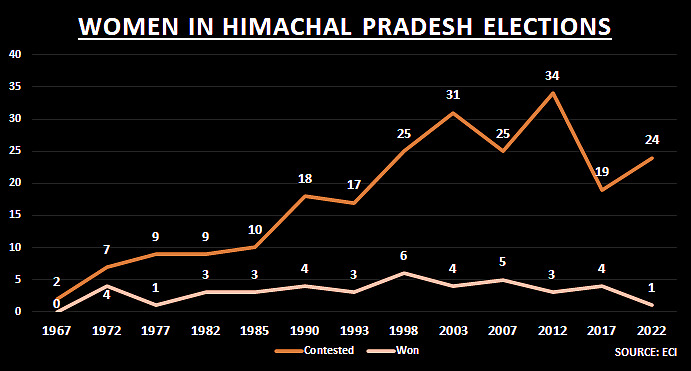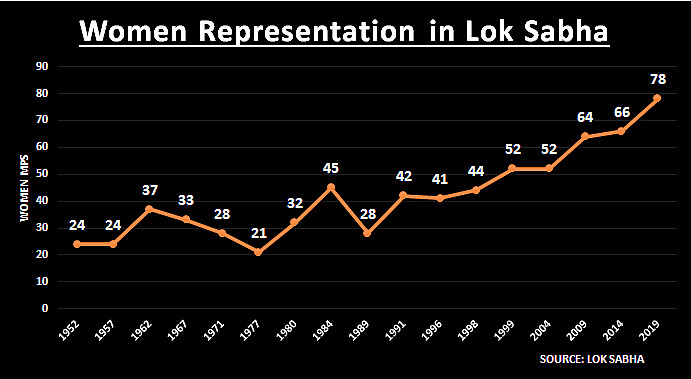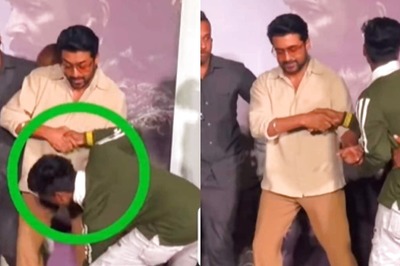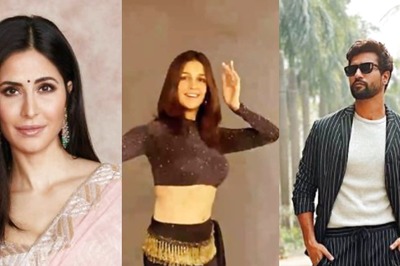
views
With just one woman elected to the Himachal Pradesh assembly with the poll results announced last week, the House has seen one of the lowest female representations in the past few years. On the other hand, in Gujarat, while the representation has gone up to 15 women, it is just eight per cent of the total strength of the House, Election Commission data analysed by News18 shows.
In Himachal Pradesh, women’s representation this time is among the lowest. It was in 1977 that just one woman was elected to the House. In 2017, four women MLAs were in the assembly. Between 1982 and 2017, women’s representation ranged from 3 to 6. In 1967, women entered the poll battle in the state for the first time with two of them in the fray. However, none made it to the House.
Further, the 68-member assembly saw the highest number of women elected to the House in 1998, when six of them won the polls. The year 2007 saw the second-highest number of women being elected – five.

Since 1967, just 41 women have made it to the Himachal Pradesh assembly. Women’s representation in the 68-member House never crossed 10 per cent, official numbers analysed by News18 show.
Similarly in Gujarat, since the first election in 1962, only 126 women have made it to the legislative assembly and their representation has also never crossed 10 per cent of the House strength, data from the Election Commission of India shows.
In the previous assembly poll in 2017, 13 women were elected to the 182-member Gujarat assembly. This number was only two more from the first assembly election in 1962, when 11 made it to the House.
The number of women MLAs in the House ranged from one to 16. Only one woman was elected to the Gujarat assembly in 1972. The highest number of elected women was 16 in 1985, 2007, and 2012.
Even in the Gujarat cabinet that took oath on December 12, out of the 17 ministers, just one is a woman.

While most political parties in India speak about women’s empowerment, when it comes to giving them space in the political picture, the numbers show it has remained just lip service.
Who fares best, worst?
The representation of women, elected in the last assembly polls held in the respective states, is low, not even crossing 15 per cent. Currently, Chhattisgarh and West Bengal have the most share of women in the assemblies, while Mizoram and Nagaland are on the other end of the spectrum with no women, government data analysed by News18 shows.
Nagaland assembly is 60-member while Mizoram is 40-member. Both these states last went to polls in 2018 and none of the members were female.

Chhattisgarh, which also went for polls in 2018, saw 13 women in the 90-member House, making it 14.44 per cent – the highest among all the states. In West Bengal, which had elections in 2021, the women’s representation is 13.6 per cent, the second highest among the states. In the 294-member assembly, 40 MLAs are women.
Jharkhand, which went for polls in 2019, has the third highest women’s representation with 10 female MLAs in the 81-member house — a little over 12 per cent.
In the last assembly polls held in Jammu and Kashmir in 2014, the female representation was just 2.3 per cent, the data shows.
Low women’s representation in Parliament
According to the data from the Ministry of Law and Justice presented in Parliament last week, women’s representation in Lok Sabha is 14.94 per cent and in Rajya Sabha it is 14.05 per cent.
The data shows that in the 2019 Lok Sabha polls, 78 women were elected to the 543-member House, a record since the first Lok Sabha polls. According to the official website, in the first Lok Sabha, formed in 1952, there were 24 women.

In Rajya Sabha, as per the official website, there are 239 members as on date and only 33 are women.

It is important to note that Parliament is yet to pass the Women’s Reservation Bill. If the long-pending proposal to provide 33 per cent reservation to women in the Lok Sabha had been passed, it could have ensured at least 179 female members in the Lower House of Parliament.
Responding to a query on the Bill, the Ministry of Law and Justice said: “Gender justice is an important commitment of the Government. The issue involved needs careful consideration on the basis of the consensus among all political parties before a Bill for amendment in the Constitution is brought before Parliament.”
In September 2022, UN Women released some facts and figures about women’s participation and leadership in political and public life. It said equal participation by women is essential to achieving the Sustainable Development Goals by 2030. “However, data show that women are underrepresented at all levels of decision-making worldwide, and that achieving gender parity in political life is far off,” it said.
Read all the Latest Politics News here



















Comments
0 comment